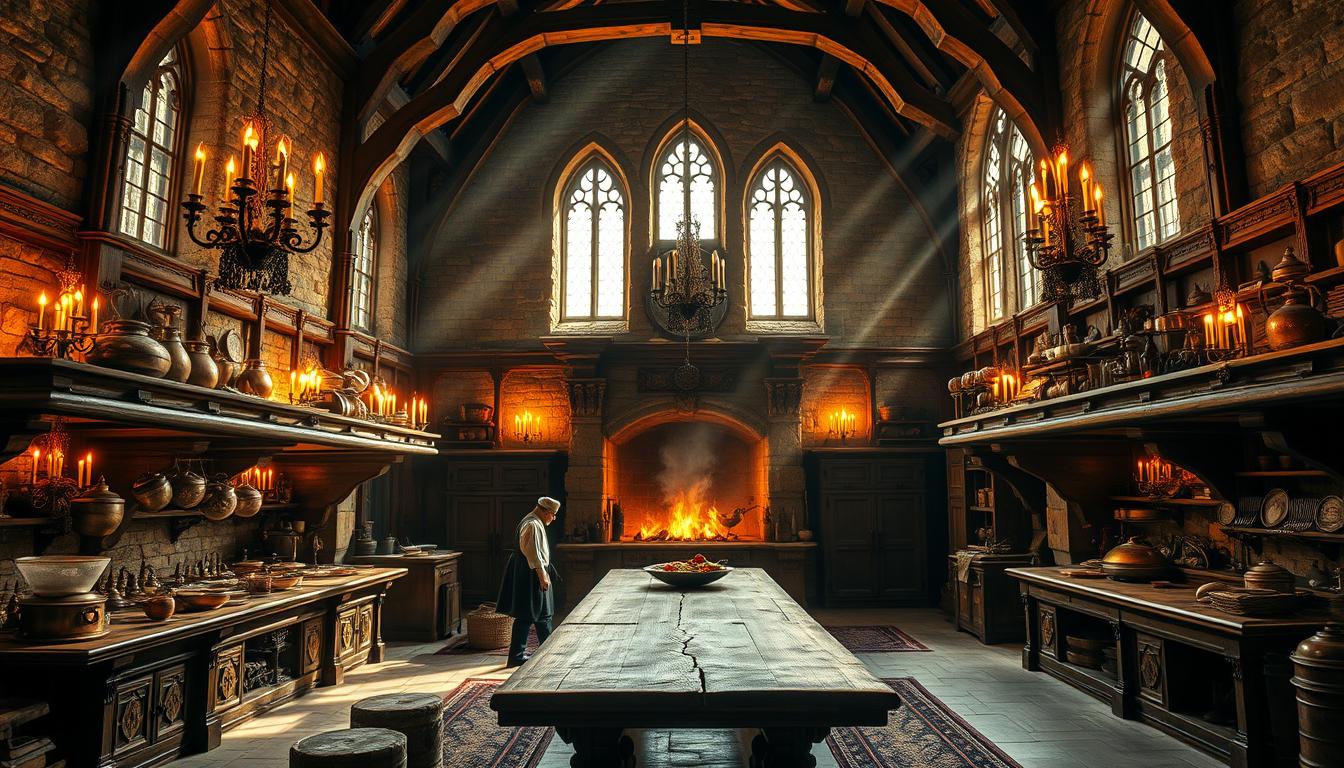Medieval charm meets modern living in the latest design trend taking over home spaces. Inspired by grand halls and rustic elegance, this aesthetic blends history with contemporary comfort. Pinterest’s 2025 trend report highlights its growing appeal, especially among younger generations.
Interior designer Stephanie Wiott praises the trend for its “grandeur and history,” noting how it transforms ordinary rooms into storybook escapes. The heart of the home—where functionality meets fantasy—becomes the perfect canvas for stone textures, dark woods, and antique metals.
Whether you’re drawn to arched doorways or wrought-iron details, this style offers endless possibilities. For those who love eclectic vibes, explore boho-inspired twists to mix with castlecore elements.
Key Takeaways
- Castlecore blends medieval inspiration with modern practicality.
- Younger generations are driving its popularity in home interiors.
- Stone, dark wood, and antique metals define the aesthetic.
- Kitchens ideal for merging fantasy and function.
- Designers like Stephanie Wiott endorse its timeless appeal.
What Is Castlecore? Enchanting Your Kitchen with Medieval Charm
Forget sterile minimalism—this trend embraces rich textures and timeless elegance. Dubbed “castlecore,” the movement blends ancient estate decor with gothic fashion influences, creating spaces that feel both regal and lived-in. Pinterest’s 2025 report notes its surge among millennials craving warmth in tech-dominated homes.
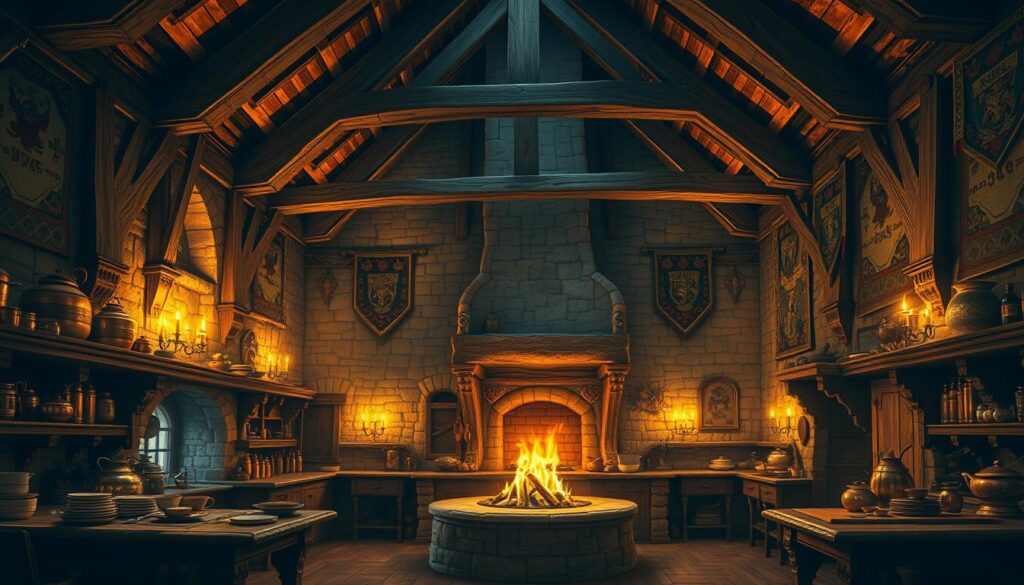
Defining the Castlecore Aesthetic
Designer Stephanie Wiott describes it as “opulent designs meeting modern comfort.” Unlike fantasy-themed rooms, castlecore prioritizes authenticity—think stone walls, dark woods, and antique metals rather than plastic swords. Decorilla experts emphasize “density and material truth”, favoring real oak over faux finishes.
Why Kitchens Shine in This Style
Natural materials like stone countertops and hardwood floors align perfectly with the aesthetic. These spaces also honor history—medieval halls were gathering spots, much like today’s cooking areas. For a twist, pair wrought-iron fixtures with boho-inspired decor to soften the drama.
| Castlecore | Modern Farmhouse | Industrial |
|---|---|---|
| Stone textures | Shiplap walls | Exposed brick |
| Antique metals | Painted wood | Steel beams |
| Dark wood tones | White cabinets | Concrete floors |
Ultimately, castlecore’s charm lies in balancing grandeur with everyday practicality—a recipe for a kitchen that feels both magical and functional.
Castlecore Kitchen Ideas: Start with a Moody Color Palette
Transform your cooking space into a regal retreat with rich, moody hues. Interior designer Stephanie Wiott suggests a 60/40 blend of stone tones and jewel colors for depth and warmth. This balance ensures a luxurious yet livable design.

Jewel Tones for Regal Richness
2025 color forecasts favor saturated shades like Backdrop’s Self-Portrait paint. For a bold look, try Farrow & Ball’s Hague Blue or Sherwin-Williams’ Rookwood Dark Green. Glossy finishes amplify these hues, reflecting candlelight for an atmospheric glow.
Earthy Neutrals to Mimic Stone Walls
Ground the drama with warm taupes and greiges. Paint niche interiors two shades darker than walls for subtle contrast. Color-blocking works wonders—pair earthy lower cabinets with emerald uppers for a modern twist.
How to Balance Dark Hues in Small Spaces
Fear not tight quarters! Use dark paint only on focal points like islands or range hoods. For a budget update, swap cabinet fronts instead of a full repaint. This keeps the space airy while adding medieval charm.
- Pro tip: Matte finishes hide imperfections in older homes.
- Budget hack: Sample $5 test pots before committing.
- Lighting fix: Pair dark walls with warm LED sconces.
Layer Textures for a Timeworn Look
Texture transforms a space from flat to fascinating in seconds. The right mix of fabrics, metals, and woods adds depth and history. Designer Stephanie Wiott calls it “the secret sauce of castlecore—every layer tells a story.”
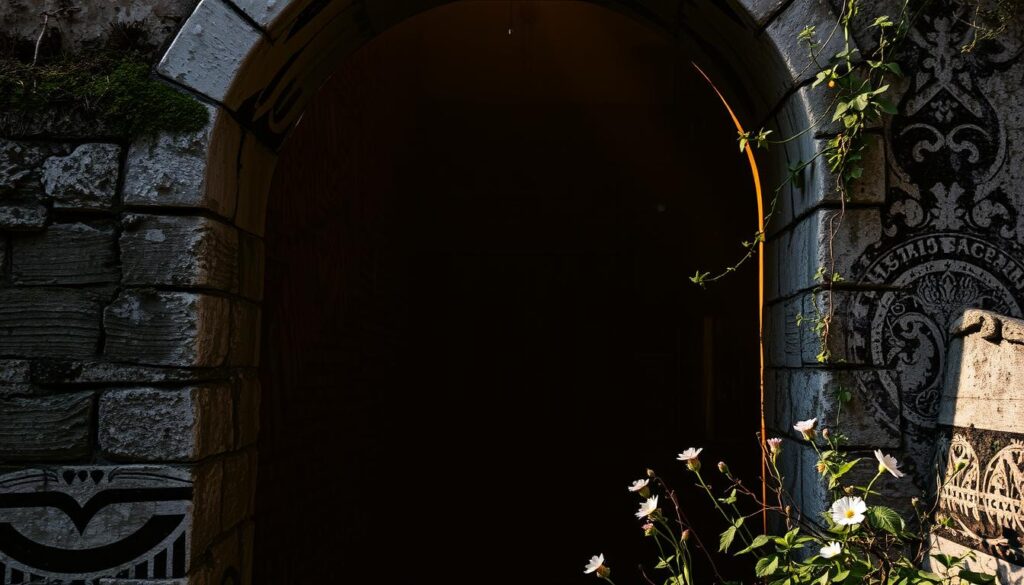
Velvet Upholstery and Heavy Drapery
Velvet barstools or curtains bring luxury without fuss. Wiott suggests using tiebacks with vintage trimmings to amplify drama. For shadow play, hang textiles 1″ from walls—a trick from historic estates.
Incorporating Antique Tapestries
Aubusson tapestries (like this $9,500 1stDibs find) anchor the room. Budget-friendly? Try Pottery Barn’s Greenwood Tapestry ($349) or DIY with Spoonflower’s medieval prints. Tapestries add instant heritage.
Mixing Rough and Refined Materials
Pair a rough-hewn oak table with velvet seating for contrast. Follow this layering sequence: stone walls → wood surfaces → metallic accents → fabric. Avoid shiny metals—unlacquered brass ages beautifully.
- Pro tip: Matte finishes hide flaws in older homes.
- Lighting fix: Warm sconces highlight textured walls.
- Do’s & don’ts: Skip polished chrome; opt for hammered iron.
Bring in Stone Elements (Without a Full Renovation)
Stone brings timeless character to any space—no medieval fortress required. Designer Stephanie Wiott’s plaster techniques and reclaimed materials make it easy to add heritage charm. Avoid overly fake finishes; authenticity keeps the decor from feeling like a movie set.
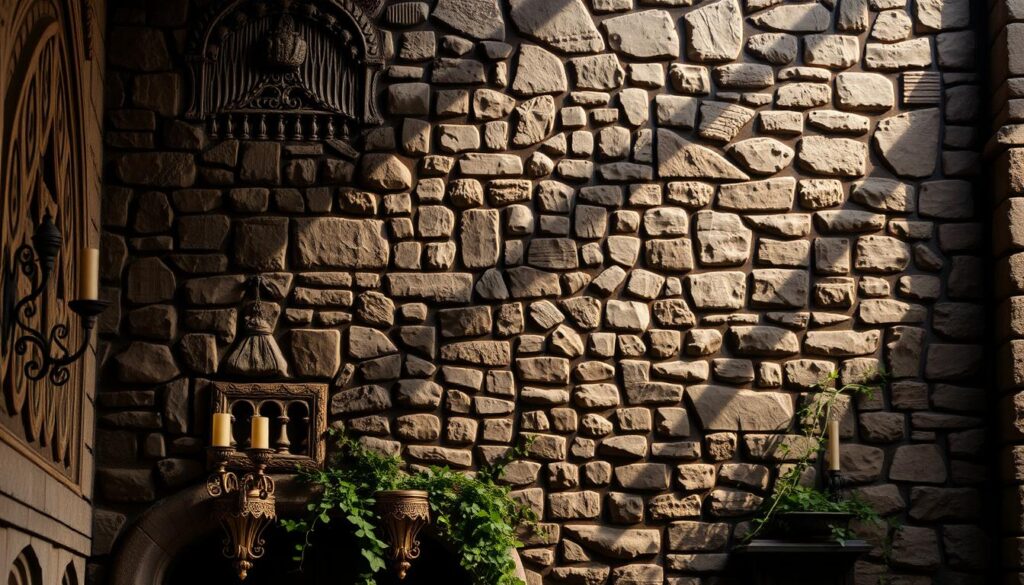
Stone Accent Walls or Plaster Finishes
Wiott’s go-to trick? “Roman Clay by Portola Paints creates a hand-troweled stone effect.” Apply it to one wall for depth. For texture, skip glossy finishes—matte plaster mimics aged walls perfectly.
Reclaimed Stone Countertops or Shelves
Salvage yards offer limestone slabs for half the cost of new. Amber Interior Design’s vintage Jungle Side Table ($1,600) shows how fragments add flair. For DIY, use stone brackets to support floating shelves.
Decorative Stoneware and Utensils
Heath Ceramics’ Tudor Collection brings rugged elegance to tabletops. Pair with Fireclay Tile’s Castle Rock mosaic for a backsplash that whispers history.
| Stone Alternative | Cost | DIY Difficulty |
|---|---|---|
| Roman Clay plaster | $50/gallon | Moderate |
| Reclaimed limestone | $20/sq ft | Hard |
| Stoneware accents | $30–$200 | Easy |
- Pro tip: Use darker grout with stone tiles for an aged look.
- Budget hack: Scour flea markets for marble cutting boards.
Choose Dark Wood Furnishings for Depth
Dark wood furnishings add instant warmth and character to any space. Rich tones like mahogany or oak create a sense of history, blending seamlessly with stone and metal accents. Designer Stephanie Wiott notes, “Wood’s natural imperfections tell a story—embrace them.”
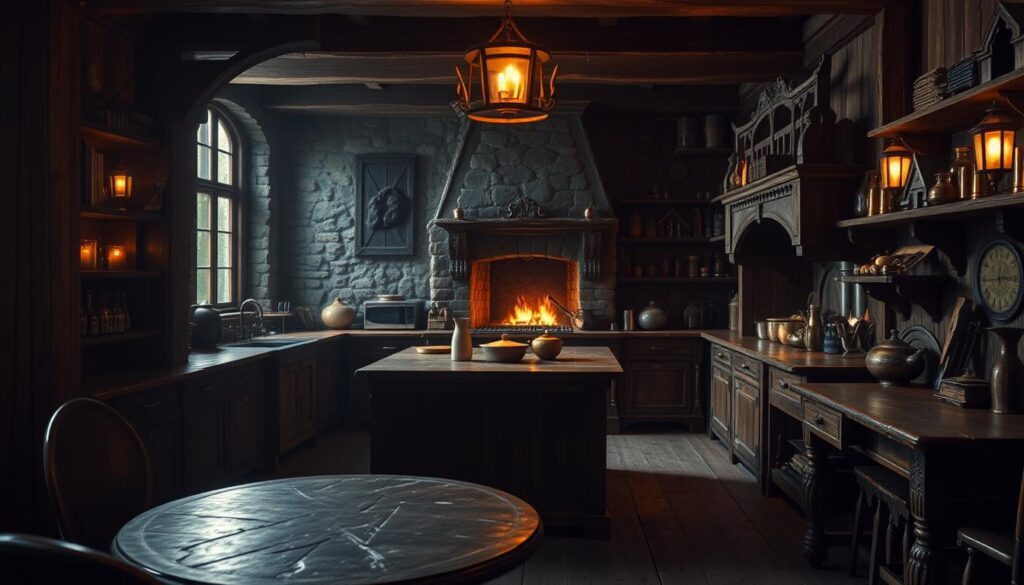
Mahogany or Oak Cabinetry
Upgrade cabinets with Zar’s Dark Walnut stain for a luxe update. For inspiration, the Henkel Harris Mahogany Bed ($1,800 at Chairish) showcases deep, reddish undertones. Uneven finishes add charm, mimicking aged estates.
Vintage-Inspired Dining Tables
Mix a New Reclaimed Timber Co. table with antique church pews for eclectic contrast. Avoid matchy sets—pair ebony stools with open oak shelving. This creates visual interest while honoring the dining area’s role as a gathering spot.
Carved Wood Decor Pieces
Anthropologie’s Gilded Grotesques corbels add whimsy to range hoods or shelves. For focal points, opt for hand-carved details that catch light beautifully.
| Wood Type | Best For | Cost Range |
|---|---|---|
| Mahogany | Cabinetry, beds | $1,500–$3,000 |
| Reclaimed oak | Tables, beams | $800–$2,500 |
| Ebony | Accent stools | $200–$600 |
Pro tip: Layer wood tones for depth—dark lower cabinets with mid-tone open shelves. The result? A space that feels curated, not staged.
Light Like a Medieval Hall: Ornate Fixtures & Ambiance
Lighting sets the mood in any space, but medieval-inspired designs take it to another level. The right fixtures add a touch of grandeur, turning everyday rooms into storybook escapes. Think iron chandeliers, flickering sconces, and warm glows that evoke historic charm.
Iron Chandeliers and Candelabras
CB2’s Lochan Wrought Iron Holder ($199) proves you don’t need a castle budget for royal flair. For a showstopper, Visual Comfort’s Ardennes Iron Chandelier mimics 15th-century designs with modern wiring. Designer Stephanie Wiott notes, “Unlacquered metals age beautifully, adding authenticity.”

Wall Sconces for Atmospheric Glow
Convert recessed lights to sconces using retrofit kits—no rewiring needed. Hang them 60″ apart to frame a fireplace or dining nook. For candle alternatives, flameless LED tapers offer flicker without fire risk.
Warm, Low-Glare Bulbs
Stick to 2700K bulbs (
- Pro tip: Use dimmers to adjust brightness for dinners vs. dishwashing.
- Budget hack: Spray-paint basic sconces with iron-finish paint.
- Do’s & don’ts: Skip cool-toned LEDs; warm light enhances stone textures.
Accessorize with Antique Metals and Vintage Finds
The right accessories can transport your home to another era without losing functionality. Mixing metals and aged materials adds depth while keeping spaces livable. Designer Stephanie Wiott advises, “Let each piece earn its place—authenticity beats perfection.”

Wrought Iron Hardware That Tells a Story
Schoolhouse’s Medieval Hinge Pull collection proves small details make big impacts. These iron pieces work equally well on cabinets or as wall hooks. For cohesion, repeat the same metal finish in at least three spots.
The Warmth of Patina-Rich Accents
Chairish’s Vintage Brass Drawer Set ($75) shows how tarnished metals add character. Don’t fear mixing brass with copper—the secret lies in varied textures. Quick aging tip: expose new brass to vinegar-salt fumes overnight.
Historic Kitchenware as Functional Decor
Display antique graters or colanders as art on open shelves. A copper mortar and pestle doubles as a striking centerpiece. Juniper Print Shop’s Bestiary art adds whimsy without overwhelming.
- Do: Cluster odd-numbered vintage finds for visual balance
- Don’t: Over-polish metals—patina equals charm
- Pro tip: Use unlacquered brass for natural aging over time
Remember: the best interiors layer history gradually. Start with one statement piece and build around it.
Conclusion: Crafting Your Own Fairytale Kitchen
Turn your home into a storybook setting with timeless touches. The trend blends rich colors, layered textures, and authentic materials for a space that feels both grand and lived-in.
Start small—a stone accent wall or dark wood cabinet sets the tone. Even apartments can embrace this style with wrought-iron sconces or velvet drapes.
Designer Stephanie Wiott sums it up: “It’s about creating your personal history.” Whether you add one piece or reimagine the whole room, let your decor reflect your story.
Ready to begin? Book a free design consultation to bring your timeless design vision to life.

